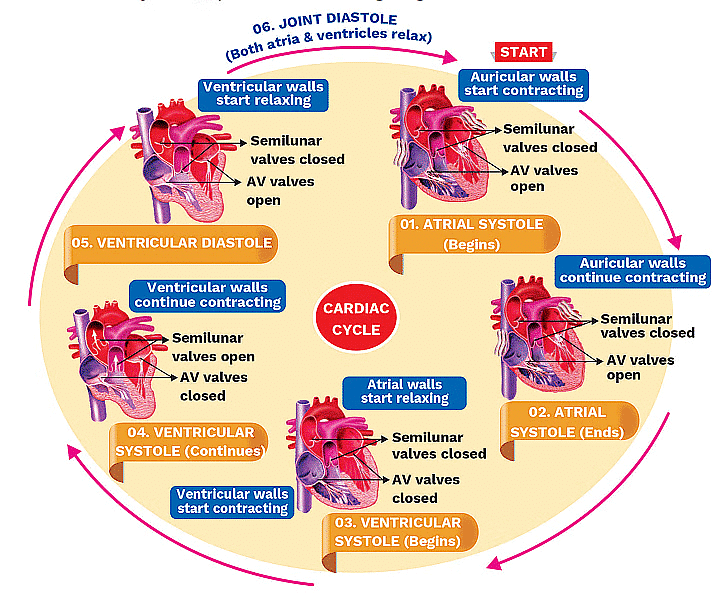NEET Exam > NEET Notes > Cardiac Cycle and ECG
Cardiac Cycle and ECG - NEET PDF Download
What is Cardiac Cycle?
The cardiac cycle refers to the sequence of events that occur during one complete heartbeat. It includes both the contraction (systole) and relaxation (diastole) phases of the heart chambers, specifically the atria and ventricles.

Steps in Cardiac Cycle
- Initially, all four chambers of the heart are relaxed, known as joint diastole. Blood from the pulmonary veins and vena cava flows into the left and right ventricles through the open tricuspid and bicuspid valves, while the semilunar valves remain closed.
- Then, the sinoatrial node (SAN) generates an electrical signal, prompting both atria to contract simultaneously (atrial systole), increasing blood flow into the ventricles by 30%.
- This signal is relayed to the ventricles, causing them to contract (ventricular systole), while the atria relax (diastole), coordinating with ventricular contraction.
- Ventricular pressure rises, the tricuspid and bicuspid valves close to prevent backflow into the atria. Further pressure opens the semilunar valves, allowing blood to be pumped into the pulmonary artery and aorta.
- After contraction, the ventricles relax (ventricular diastole), and their pressure decreases, causing the semilunar valves to close, preventing backflow. As ventricular pressure continues to drop, the tricuspid and bicuspid valves reopen due to pressure from the blood in the atria, and the cycle restarts.
- This repeating sequence is called the cardiac cycle, comprising systole (contraction) and diastole (relaxation) of both atria and ventricles.
- Typically, the heart beats 72 times per minute, indicating a cardiac cycle duration of 0.8 seconds.
- Each ventricle pumps about 70 mL of blood per beat (stroke volume), and multiplying this by the heart rate gives the cardiac output, averaging 5000 mL or 5 liters per minute in a healthy person.
- The body can adjust stroke volume and heart rate, affecting cardiac output, as seen in athletes with higher cardiac outputs.
- During each cycle, two distinct sounds are produced and can be heard with a stethoscope: the first heart sound (lub) coincides with tricuspid and bicuspid valve closure, while the second sound (dub) accompanies semilunar valve closure. These sounds have diagnostic significance in clinical settings.
Electrocardiograph (ECG)
Electrocardiography (ECG) is a method used to obtain a graphical representation of the heart's electrical activity during a cardiac cycle.
 Electrocardiogram
Electrocardiogram
- During a standard ECG, a patient is connected to an electrocardiograph machine with three electrical leads placed on the wrists and left ankle to monitor heart activity continuously.
- For a detailed evaluation, multiple leads can be attached to the chest region, but we'll focus on the standard ECG here.
- Peaks in the ECG are labeled from P to T and correspond to specific electrical events in the heart.
- The P-wave indicates the electrical excitation (depolarization) of the atria, leading to their contraction.
- The QRS complex represents the depolarization of the ventricles, initiating their contraction and marking the beginning of systole.
- The T-wave signifies the repolarization of the ventricles, returning them to their normal state, and marks the end of systole.
- Counting the number of QRS complexes in a given time period allows determination of an individual's heart rate.
- ECGs from different individuals typically have similar shapes for a given lead configuration, so any deviation indicates a potential abnormality or disease, making ECGs clinically significant.
Related Searches


















